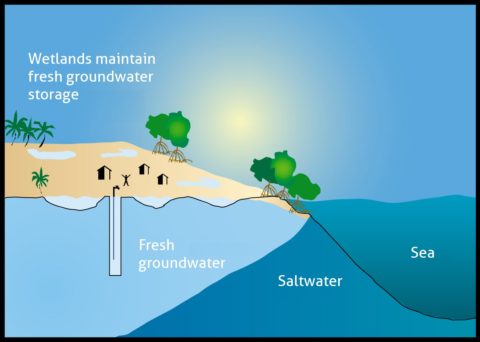
Understanding water as a commoner
I used to see water as something that flows down as I open a faucet. It is essential for life, for us. We need it everyday, for almost everything. But what is important to remember is that this unhindered flow of usable, clean, freshwater is not something to take for granted. Over last few months my perspective to water changed drastically. And when I say the word “water,” to me, now, it means way more than what it used to. This is an attempt to unfold the intricacies of water – the fact that water is more than just an element and its supply and quality depends on a whole lot of other things.
Water means usable, pure freshwater
We know that one third of this planet is water. And still why do we make such fuss about it? Because only 3% of this water is freshwater, among which 2% is stored in form of ice in the arctic zones. That leaves us with 1% freshwater. It does not seem like a big number for 120 billions of humans. We, humans, need freshwater for drinking, for hygiene and sanitation, for cooking and irrigation, for fishes, for growing plants and trees, for nurturing our cattle and domestic fowls. And the list goes on. For all these, we only have 1% of freshwater and event not all of it is pure or usable. When we talk about water, sanitation and hygiene or water security, we predominantly mean usable, pure freshwater.
Where does this water come from?
The freshwater we use mainly comes from underground, streams, lakes, rivers, ponds and such other freshwater stores. These water bodies within an area do not exist separately; they are interconnected like the arteries in our body. They are connected through a water system and the heath of these water bodies is also interdependent. Let’s take the example of a coastal freshwater lake. The lake is linked to underground freshwater store. When there are floods or heavy rain, the lake works like a sponge and absorbs the extra water, which recharges the underground water store. Meanwhile, this underground water, which is stored in a bubble, prevents the saline water from contaminating the lake’s freshwater. That’s how the freshwater sources help each other to stay healthy and functional.

And “water” is more than water in human terms
Freshwater is not just drinking and sanitation for humans. Freshwater means fishes, pastures, plants, dragonflies, birds and beasts. That leads to another set of connotations that “water” comes with, in another word, another system that water is essential for. Freshwater hosts a whole range of life forms and consequently, provides people with a multiple number of invaluable benefits. And the most important part of this relation is that these life forms are all interconnected and interdependent – even the tiniest worm within a system has a role equal to a majestic mammal. They are connected like dominoes. For example, the water quality of coastal wetlands depends on mangroves and healthy growth of mangroves depends of mudcrabs.
So, water means wonders
To conclude, water is a not a separate entity or element, the way we, humans, often like to conceptualise it. Water is part of many different natural systems. That’s why we use the word “wetlands” – a word that embraces every dimension of water – the flow, the flora, the fauna. And now, when I say “water,” it reminds me of the primitive connection humans share with the planet since the origin of everything. It fills everything and leaves no void. Water cannot be controlled, bound within boundaries, cut into pieces or captured into a cage. The flow of water embodies the unrestrained drift of time, the perpetuity of change, the breath and breadth of collective consciousness, the strength of pliability and the mellifluous, the power of love and kindness. That’s why we strive for letting water be, home nature, harbour humans and embrace all lives into its ever-stretching arms of beauty, benevolence and blessings.
